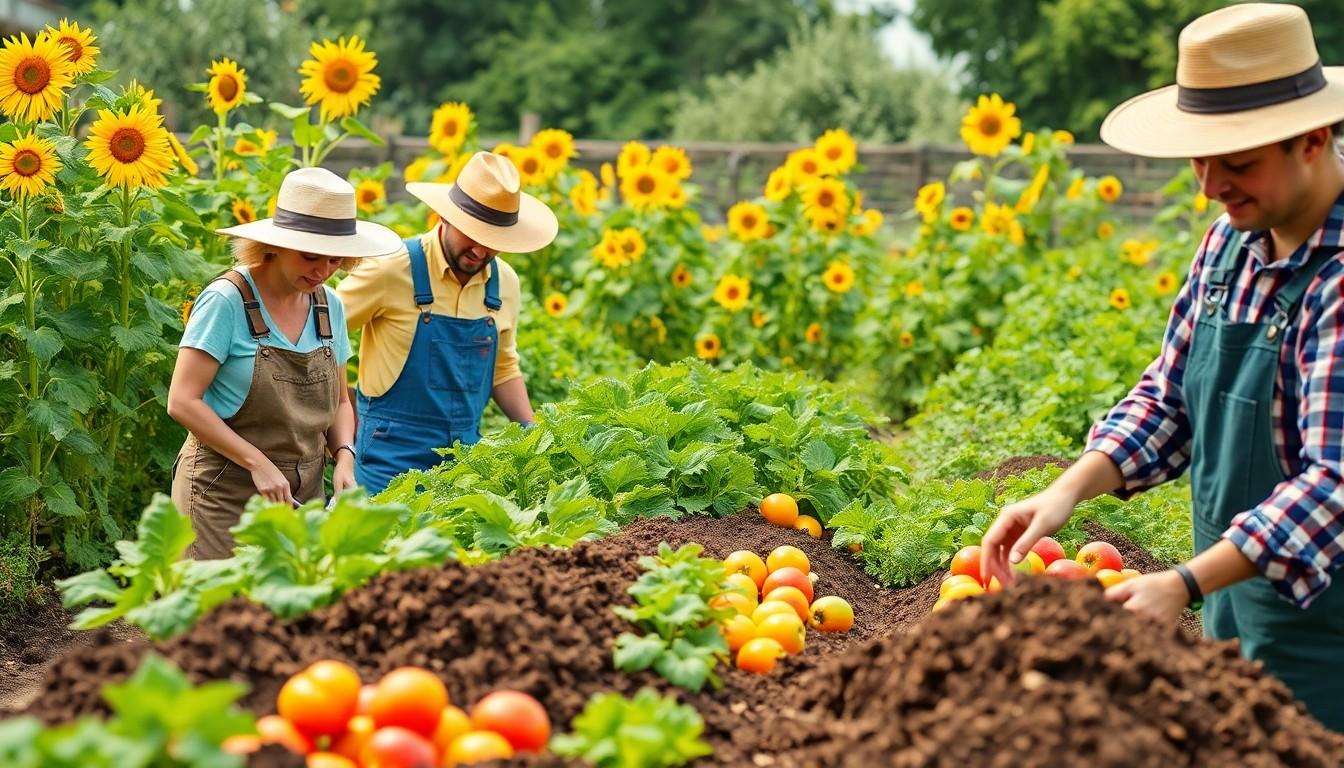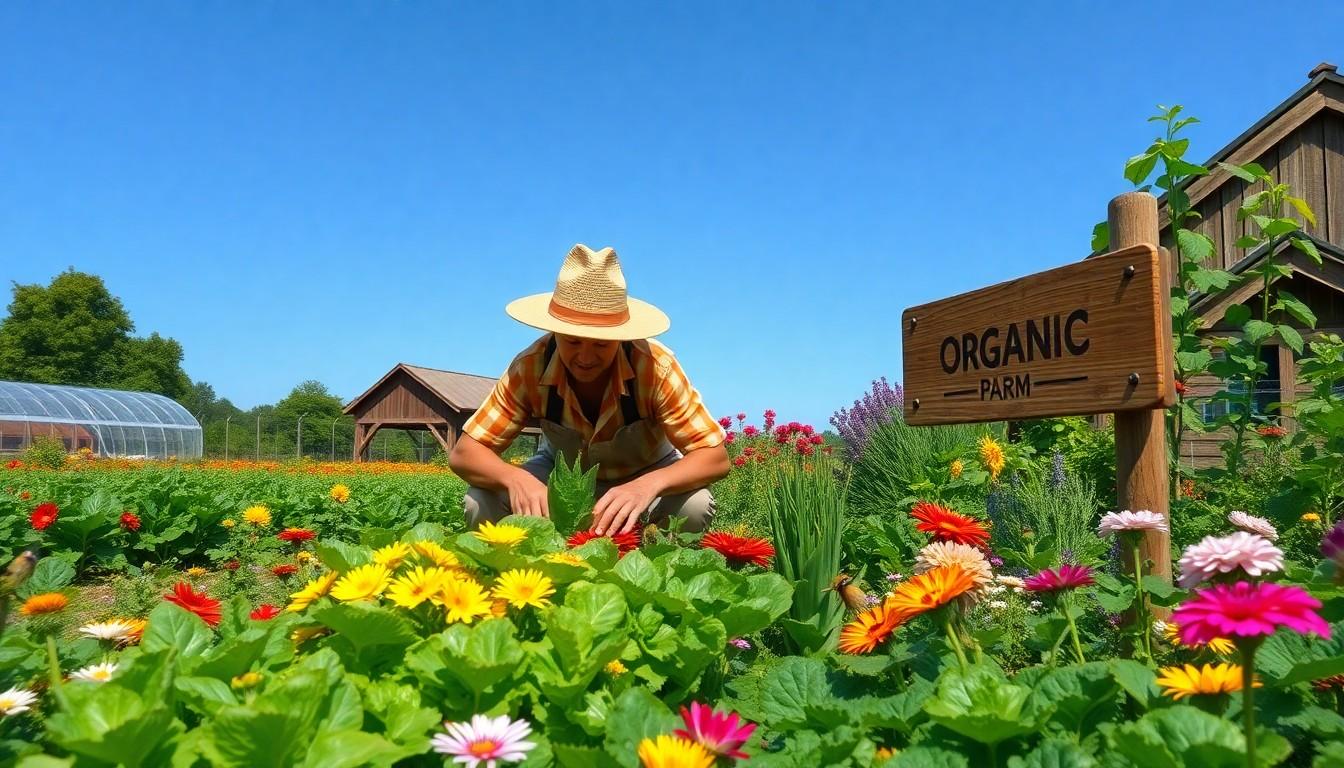Physical Address
304 North Cardinal St.
Dorchester Center, MA 02124

In a world where chemicals seem to rule the farm, organic farming methods are like a breath of fresh air—or maybe a whiff of freshly turned compost. These eco-friendly practices not only nurture the planet but also produce food that’s as wholesome as grandma’s secret recipe. Who wouldn’t want to munch on veggies that are grown without the funky stuff?
Organic farming emphasizes sustainable practices that prioritize soil health and biodiversity. Crop rotation helps in maintaining soil fertility and preventing pests, enhancing agricultural resilience over time. Cover cropping protects the soil and adds nutrients, promoting a healthy ecosystem.
Companion planting reduces pest issues while maximizing space and improving crop yields. Natural pest management strategies include using beneficial insects and organic pesticides, ensuring crops remain untainted by harmful chemicals. Farmers implement composting to recycle organic matter, enriching soil and reducing waste.
Mulching enhances soil moisture retention and suppresses weeds while improving nutrient availability. Organic fertilizers, such as manure and compost, support plant growth without synthetic additives. These practices not only bolster crop production but also contribute to overall environmental protection.
Farmers often utilize agroforestry, integrating trees with crops to enhance biodiversity. This method provides shade, reduces erosion, and creates habitats for various species. Biodynamic farming, a subset of organic methods, incorporates holistic practices, including specific planting schedules and herbal preparations, ensuring balanced ecosystems.
Each organic farming method plays a crucial role in achieving sustainable agricultural outcomes. These methods work collectively to produce wholesome food, offering a viable alternative to conventional agriculture. Adopting organic practices supports the long-term health of the planet, benefiting farmers and consumers alike.

Organic farming methods offer numerous advantages, especially concerning environmental health and personal well-being. These benefits make organic practices increasingly vital in modern agriculture.
Organic farming significantly reduces chemical runoff in water systems. This reduction leads to cleaner waterways, promoting healthier aquatic ecosystems. Soil health improves due to practices that focus on sustainable management. Crop rotation maintains soil fertility, while cover cropping prevents erosion. Biodiversity increases as organic farms often incorporate diverse plants and animals. The absence of synthetic fertilizers and pesticides lessens pollution and enhances natural pest control. These eco-friendly methods contribute to a more resilient ecosystem.
Consumption of organic produce lowers exposure to harmful chemicals. Farmers use natural techniques that prioritize human health, resulting in safer food options. Nutritional quality often improves, as studies indicate higher vitamin and antioxidant content in organic vegetables and fruits. Additionally, organic farming practices foster a healthier food system, free from genetically modified organisms. Eating organic aligns with many consumers’ values, promoting overall well-being and environmental sustainability. Organic methods also support local economies, strengthening community ties and enhancing food security.
Organic farming employs several methods that enhance soil health and promote sustainability. These techniques focus on maintaining biodiversity and reducing chemical use.
Crop rotation involves alternating different crops in a specific sequence over time. This method prevents soil depletion, as various plants require different nutrients. By rotating crops, farmers disrupt pest and disease cycles, resulting in healthier plants. Different crops may also improve soil structure, leading to better water retention. For instance, following legumes with cereals boosts nitrogen availability in the soil.
Cover cropping integrates specific plants into farming systems during off-season periods. These plants shield the soil from erosion while enriching it with organic matter. Benefits include improved soil fertility and reduced weed pressure. Farmers often choose legumes to fix nitrogen, enhancing nutrient availability for subsequent crops. The presence of cover crops can also improve soil moisture retention, leading to better yields.
Composting transforms organic matter into nutrient-rich soil amendments. This process involves decomposing materials like kitchen scraps and yard waste over time. Nutrients from compost enhance soil fertility, promoting plant growth without synthetic fertilizers. Additionally, compost improves soil structure, water retention, and microbial activity. Farmers often apply compost in gardens or fields, yielding healthier crops throughout the growing season.
Biological pest control utilizes natural predators to manage pest populations. This method reduces reliance on chemical pesticides, benefiting both the ecosystem and human health. Ladybugs, for instance, effectively target aphids while maintaining balance in the food web. Farmers strategically introduce beneficial insects to control pests, leading to healthier agricultural systems. This approach ultimately fosters biodiversity, contributing to sustainable farming practices.
Organic farming faces several challenges that can impact its success and scalability. Addressing these challenges ensures effective implementation of sustainable practices.
Effective pest management presents significant hurdles for organic farmers. Natural pesticides, while safer, may lack the potency of synthetic alternatives. Organic farmers rely on biological controls, such as ladybugs for aphid control, but these methods often require careful monitoring. Crop diversity aids in deterring pests, yet it may complicate management practices. Seasonal pest pressures can heavily tax resources, limiting effective outcomes for farmers. A strategy involving companion planting may enhance pest resistance, but it demands additional knowledge and planning.
Soil fertility management poses another critical challenge in organic farming. Organic farmers avoid synthetic fertilizers, which complicates soil nutrient replenishment. Cover cropping improves soil quality, but improper timing or selection can reduce effectiveness. Organic amendments, such as manure, provide nutrients but require careful application to avoid over-fertilization. Crop rotation aids in enhancing nutrient cycling, yet may not yield immediate results for farmers reliant on short-term outputs. Regular soil testing becomes essential for monitoring fertility levels, demanding resources that not all farmers can afford, especially small-scale operations.
Limited market accessibility hinders growth for many organic farmers. Consumer demand for organic products often outpaces supply, yet reaching markets can be challenging. Certification processes, while necessary, can be time-consuming and costly, posing hurdles for new entrants. Small-scale farmers may struggle to compete against large organic operations that dominate the market. Additionally, distribution networks can be underdeveloped, creating gaps in availability for consumers. Building relationships with local markets and retailers becomes imperative to overcome these barriers and expand market access.
The future of organic farming methods hinges on innovation and sustainability. Advancements in technology enhance precision agriculture, allowing farmers to optimize resource use while adhering to organic principles. Automation tools, such as drones, facilitate crop monitoring and data collection, improving decision-making.
Collaboration among farmers plays a crucial role in disseminating knowledge and best practices. Community-supported agriculture (CSA) models strengthen local food systems, enabling consumers to connect directly with producers. Increased consumer demand for transparency drives the adoption of organic practices.
Investment in research accelerates the development of improved organic methods. Genetic studies focus on creating resilient crop varieties that withstand challenges such as climate change and pest pressures. Promoting education around organic methods in academic institutions prepares future generations of farmers.
Regulatory frameworks continue to evolve, balancing consumer protection with the need for market growth. Transitional programs support conventional farmers moving toward organic practices, fostering a more sustainable agricultural landscape. Additionally, enhanced certification processes ease barriers for small-scale producers seeking to enter the organic market.
Engagement in agroecological initiatives supports biodiversity and improves soil health. Practices such as agroforestry and permaculture contribute to ecosystem resilience, providing multiple benefits for both farmers and consumers. Addressing challenges in organic farming, such as pest management and soil fertility, remains a priority.
The integration of local crops into organic farming systems enhances nutritional diversity. Consumers increasingly seek localized products, reinforcing the importance of sustainable farming methods. As organic farming evolves, it shapes a sustainable agricultural future, benefiting the environment, health, and local economies.
Organic farming methods represent a vital shift toward sustainable agriculture. By prioritizing soil health and biodiversity, these practices not only produce healthier food but also contribute to a cleaner environment. As challenges persist in pest management and market access, the commitment to innovation and community collaboration remains essential.
The future of organic farming looks promising as technology and research pave the way for improved techniques. This evolution not only supports farmers but also aligns with consumer values around food safety and environmental responsibility. Embracing organic methods fosters a healthier planet and a more resilient food system for generations to come.